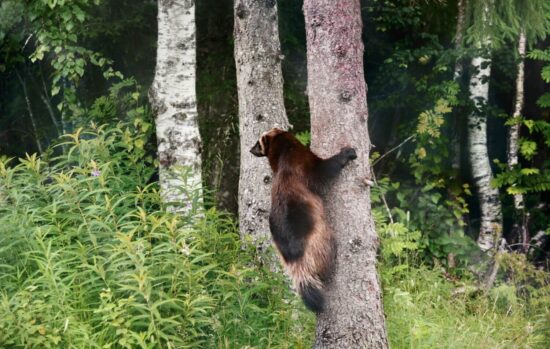Imagine that you’re hiking through the woods when suddenly you spot a massive bear. Your first instinct might be to scramble up the nearest tree for safety. But here’s some knowledge that could save your life: most bears are actually better climbers than you are.
This common misconception has put people in serious danger for years. The truth about bear climbing abilities is both fascinating and important for anyone who spends time in bear country. Let’s break down exactly which bears can climb, how they do it, and what this means for your safety.
Can Bears Climb Trees?
Out of the eight bear species in the world, seven of them can climb trees. Black bears are especially impressive, able to climb 100 feet up a tree in just 30 seconds. That’s faster than most people can run the same distance on flat ground.
The only bear that can’t climb trees is the polar bear, and that’s mainly because they’re huge and there aren’t any trees in the Arctic anyway. Every other bear species has some level of tree climbing ability, though some are much better at it than others.
The Champion Climbers
These bear species have mastered the art of tree climbing and spend significant time above ground.
Black Bears
American black bears are the undisputed champions of bear climbing. Their short, curved claws make black bears excellent tree climbers, and they use this skill throughout their lives. Cubs learn to climb almost as soon as they can walk, scrambling up trees when mom signals danger.
Adult black bears don’t lose this ability either. They regularly climb trees to reach food like berries, nuts, and bird eggs. Black bears can run up to 35 miles per hour, and they can climb almost as fast as they run. This means if you’re being chased by a black bear, climbing a tree will just give you a front row seat to watch the bear follow you up.
Sun Bears
In the Malay language, the sun bear is called “basindo nan tenggil,” which means “he who likes to sit high”. These small bears from Southeast Asia take tree living to the next level. Sun bears are “the most arboreal (tree-living) of all bears” and regularly “sunbathe or sleep in trees 2 to 7 meters above the ground”.
Sun bears have specially adapted bodies for climbing. Their unique features include “inward-turned front feet, flattened chest, and powerful forelimbs with large claws” that make them perfect for life in the trees. They build nests in branches for napping and spend much of their time high above the forest floor looking for food.
Asiatic Black Bears and Spectacled Bears
Asiatic black bears share many climbing abilities with their American cousins. They climb for food and safety, but they have one unique behavior: Asiatic black bears are special among bears because “they also hibernate in trees”.
Spectacled bears, found in South America, might be the most dedicated tree climbers of all. The Andean bear “spends more time in the trees than any other bear species” and “can not only climb large, thick trees but is also able to climb up smaller diameter trees, branches, and even vines”.
The Moderate Climbers
These bears can climb trees but face physical limitations that make it more challenging.
Grizzly Bears
Grizzly bears present an interesting case. While grizzly bears are capable of climbing trees, they are limited by the size and strength of the tree itself. Young grizzly cubs are actually excellent climbers, but as they grow larger and heavier, climbing becomes much harder.
Grizzly bears have notably longer and more curved claws than black bears, but these claws are designed for digging, not climbing. Grizzly bear claws are much longer, more blunt and are used primarily for excavating food from the ground.
Adult grizzlies can still climb when they really want to, but they prefer trees that are sturdy and have lots of branches. Grizzly bears typically prefer to climb trees that are straight and have a diameter of at least 10 inches.
The Poor Climbers
These bear species struggle with tree climbing due to physical adaptations or body design.
Sloth Bears
Here’s where things get interesting. Despite their name connecting them to tree sloths, sloth bears are actually clumsy climbers compared to other Asian bears. This might come as a shock since many people assume they’re great climbers.
Sloth bears have “traded in their climbing claws for their digging claws” because they specialize in eating termites and ants. Their long, powerful claws are perfect for tearing into termite mounds but not so great for gripping tree bark.
This climbing limitation has had a major impact on sloth bear behavior. Since they “can’t climb to escape potential predators, they have gotten more aggressive”. This helps explain why sloth bears are responsible for more attacks on humans than any other large carnivore species globally between 1950-2019.
Giant Pandas
Giant pandas can climb trees, but they’re not graceful about it. Giant pandas climb trees “using their hind legs to push up, then using their front legs, appearing almost caterpillar-like”. They mainly climb for defense rather than to find food, since they spend most of their time eating bamboo on the ground.
Polar Bears
Polar bears are the only bears that truly can’t climb trees. Polar bears are simply “too heavy” and “the largest specimen recorded weighed 2,209 pounds”. Animals that size just can’t support themselves on tree branches.
Plus, there are “hardly any trees in their frozen habitat to climb, even if they could”. Polar bears have evolved for life on ice and in water, not in forests.
How Bears Actually Climb
Bears use specific techniques and physical adaptations to move up trees with surprising speed and efficiency.
The Basic Technique
Bears climb using a technique called “bear-hugging,” where they wrap their front legs around the trunk and push up with their powerful hind legs. It’s like a combination of hugging and climbing that lets them move up trees surprisingly quickly.
Smaller bears like black bears, sun bears, and spectacled bears “almost run up trees” using their claws to grip the bark, front legs to pull upward, and hind legs to push. The whole process happens so fast it can look almost effortless.
Claw Adaptations
Bear claws are made of keratin, the same stuff that makes up human fingernails, but they’re much thicker and stronger. Black bear claws are “generally shorter and more straight, typically about 1 to 2.75 inches long” and “are adapted more for climbing trees”.
Grizzly bears have “notably longer and more curved claws” with “the curvature and length being adaptations to their digging habits”. This shows how different bear species have evolved different tools for different lifestyles.
Why Bears Climb Trees
Bears have several important reasons for spending time in trees, from finding food to staying safe.
Food, Food, Food
The main reason bears climb trees is to get food. Trees provide access to fruits, nuts, berries, bird eggs, and honey that bears can’t reach from the ground. American black bears will climb trees for “fruit, bird eggs, cactus fruit, honey, acorns, and berries”.
Sun bears are especially dependent on tree climbing for food. They use their excellent sense of smell to locate insects, fruits, and small animals in the forest canopy, then climb up to collect their meals.
Safety and Protection
Bears also climb trees for safety. Black bears may climb trees to “escape mountain lions, wolves, or even grizzly bears”. Mother bears often send their cubs up trees when they sense danger, keeping the little ones safe while mom deals with whatever threat is approaching.
Rest and Shelter
Some bears use trees as bedrooms. Sun bears build day beds in tree branches where they can nap safely above ground level. Asiatic black bears are unique because they “also hibernate in trees”, spending their winter sleep period high above the ground.
The Dangerous Myth About Tree Climbing
Here’s the part that could save your life: climbing a tree will not save you from a bear. This is one of the most dangerous myths about bear safety.
Why This Myth Is So Dangerous
Not only can bears climb better than humans, but “once up a tree, you’ve got nowhere else to go”. You’ve essentially trapped yourself with an animal that can follow you up and is much stronger than you are.
Bears sometimes fight each other in trees, and “the lower bear typically dominates, using gravity against its opponent”. This same principle applies to humans. A bear below you in a tree has all the advantages.
Real Cases of Tree Attacks
There are documented cases of bears attacking people who were already in trees. One hunter learned the hard way that “a black bear can climb a tree, faster than I can” when he encountered bears while hunting.
The bottom line is simple: you cannot outrun or out-climb a bear. Bears are faster, stronger, and better climbers than humans.
What to Do Instead: Real Bear Safety
Since climbing trees won’t save you, here’s what actually works when it comes to bear encounters.
Before You See a Bear
The best bear encounter is the one that never happens. Most bears will avoid humans if they hear them coming. Make noise while hiking, travel in groups, and stay alert in areas with known bear activity.
Always carry bear spray if you’re in bear country. It’s more effective than trying to outrun or out-climb a bear.
If You Encounter a Bear
First, try to identify what type of bear you’re facing. Grizzly bears “tend to have rounded ears and a concave face,” while black bears have “oval ears and conical nose”. The color of the fur isn’t reliable since both species can range from black to brown.
Black Bear Encounters
Black bears “tend to be less aggressive and more easily frightened”. If a black bear becomes aggressive, “try to scare it away by making yourself look as big as possible, making noise, and throwing objects in its direction”.
If a black bear attacks you, “DO NOT PLAY DEAD” and instead “fight back using any object available”.
Grizzly Bear Encounters
Grizzly bears require a different approach. If you’re facing a grizzly bear, “you should not attempt to fight back”. If a grizzly attacks, “play dead! Keep your pack on, lay flat on your stomach, cover your head, and attempt to be as still and quiet as possible”.
What Never to Do
Never run from a bear because “it can cause a predatory reaction”. Do not try to climb a tree because “you cannot outrun or out-climb a bear”.
The Evolution of Bear Climbing
Understanding how bears developed their climbing abilities helps explain why different species have such different skills.
Forest Origins
Bears are forest animals at their core and “evolved in forests”. Tree climbing ability appears to be one of the basic bear traits that most species have kept throughout their evolution.
Some bears, like brown bears and polar bears, eventually moved into more open environments, but they started as forest dwellers. This explains why even grizzly bears retain some climbing ability.
Evolutionary Trade-offs
Different bear species have made different evolutionary choices about climbing. Sloth bears “evolved to take advantage of termites and ants on the open landscape” and traded some climbing ability for better digging tools.
Polar bears went the opposite direction, completely giving up tree climbing in favor of swimming and ice navigation skills.
Closing Thoughts
So, can bears climb trees? Absolutely. Seven out of eight bear species are capable climbers, with some being absolutely spectacular at it. Black bears can climb 100 feet in 30 seconds, sun bears live much of their lives in trees, and even massive grizzly bears can scale trees when they want to.
This means the old advice about climbing a tree to escape a bear is not just wrong but dangerous. Both black bears and grizzlies can climb trees, and they’re much better at it than humans are.
The next time you’re in bear country, remember that your safety depends on proper preparation, making noise, carrying bear spray, and knowing how to respond appropriately to different bear species. Leave the tree climbing to the bears. They’re the experts, and they’re not giving up that advantage anytime soon.
Understanding bear climbing abilities helps us appreciate these amazing animals while staying safe in their territory. Whether it’s a sun bear building a nest 20 feet up or a black bear cubs scrambling to safety, watching bears in trees is a reminder of just how adaptable and skilled these creatures really are. Just make sure you’re watching from a safe distance on the ground.


